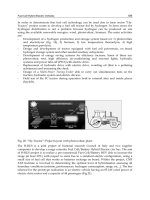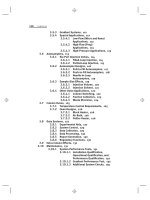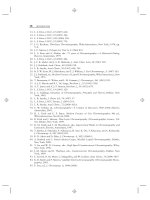Introduction to GPS The Global Positioning System - Part 7 pot
Bạn đang xem bản rút gọn của tài liệu. Xem và tải ngay bản đầy đủ của tài liệu tại đây (143.44 KB, 9 trang )
7
GPS Data and Correction Services
GPS users employ differential techniques to achieve the highest possible
positional accuracy. A straightforward manner of doing this is to use two
GPS receivers, a base and a rover, as discussed in Chapter 5. However, this
may not be cost effective in many instances. An alternative, which could
significantly reduce the survey cost without degrading the positional accu-
racy, is to use one of the available GPS data and correction services. If such
a service is available within the project area, a GPS user would only need
one receiver to be used as a rover; no base receiver is required. A number of
various GPS services are currently available with various levels of accuracy
and cost. Some services are even provided with no user fees required.
For high-accuracy static positioning, primarily for establishing new
control points, GPS users may use one of the highly precise permanent GPS
reference station networks established by several organizations around the
world. These services are currently available free of charge at the global
level [e.g., the International GPS Service for Geodynamics (IGS) network]
as well as at the regional level [e.g., the Continuously Operating Reference
Station (CORS) network in the United States] [13]. The Canadian Active
Control System (CACS) is another regional GPS service, which is available
to users at nominal fees [4]. The reference stations within these systems are
91
operating on a continuous basis, and provide access to the modern refer-
ence frames, such as the ITRF and the improved NAD 83.
Some countries around the world have established networks of refer-
ence stations around their coastal areas, which continuously broadcast
real-time DGPS corrections in a special format known as the RTCM for-
mat (see Chapter 8). This service is primarily designed to enhance the
safety of marine navigation, but is available at no cost to all users within the
coverage area. Although this service is available primarily free of charge, it
requires a beacon receiver connected to a GPS receiver that accepts the
RTCM corrections [5]. GPS receivers that accept the RTCM corrections
are commonly known as differential-ready GPS receivers. The accuracy
obtained from such a service is usually in the range of a submeter to a few
meters.
At the commercial level, two real-time DGPS correction services are
widely used. One broadcasts the DGPS corrections through FM broadcast
stations, while the other through communication satellites [68]. The
DGPS corrections from the two systems are based on the DGPS corrections
from a network of ground reference stations that cover a wide area, for
example, a continent. The system is therefore known as the wide-area
differential GPS (WADGPS). Both systems require a special receiver to
decode the DGPS correction information, which would be interfaced to
the GPS rover receiver to output positional information at the meter-level
accuracy. WADGPS systems have several advantages over conventional
single-station DGPS systems, including coverage of large, inaccessible
regions using fewer reference stations [9].
Multisite, real-time, carrier-phasebased RTK positioning at sub-
decimeter-level accuracy is a new service that is currently being developed
[10]. With this service, as little as four GPS reference receivers could cover
an entire city or even a number of adjacent small cities. Advancements
in wireless communication and the Internet are expected to make this
service very promising [11]. This chapter summarizes each of the GPS
services.
7.1 Data service
Several organizations around the world have established highly precise
permanent GPS reference station networks, which are used for various
92 Introduction to GPS
geodetic purposes. The GPS data collected at these reference stations
is made available to users, and could be used for high-accuracy static-
positioning operations, such as establishing new control points. One such
organization is the IGS, which is a service with international multiagency
membership to support global geodetic and geophysical activities [1]. The
International Association of Geodesy (IAG) has formally recognized the
IGS since 1993. The IGS service is accomplished through a global network
of 250 tracking stations (as of April 2001) equipped with continuously
operating dual-frequency receivers and a number of data and analysis cen-
ters. Figure 7.1 shows the current IGS tracking stations.
The raw GPS data collected at each tracking station is formatted in a
standard format, called the Receiver Independent Exchange (RINEX) (see
details in Chapter 8), by the operational data centers. The formatted data is
then collected by the global data centers for archiving and providing on-
line accessibility. At this stage, the analysis centers use the on-line data to
create a number of products. These products include GPS precise ephem-
eris, satellite and tracking station clock information, tracking station coor-
dinates and velocities, and Earth rotation parameters. There are different
quality levels for the precise ephemeris, depending on the time of availabil-
ity (see Chapter 8).
GPS Data and Correction Services 93
Figure 7.1 IGS tracking stations. (From />TEAMFLY
Team-Fly
®
IGS GPS data and products are currently available, at no cost, to users
worldwide through the Internet (the IGS URL address is given in Appendix
B). The data is available in the standard RINEX format. It should be
pointed out that both the IGS precise ephemeris and the tracking station
coordinates are referred to the ITRF reference system. That is, if a user
employs the IGS precise ephemeris, his or her solution coordinates will be
referred to the ITRF reference system. In North America, users could also
access GPS data through the CORS and CACS networks, which are oper-
ated by the U.S. NGS and Geomatics Canada, respectively [3, 4]. One
advantage of using CORS and CACS data is that the reference stations are
relatively closer to each other. Additionally, the precise ephemeris and the
coordinates of the reference stations may be obtained in either of the ITRF
or the improved NAD 83 systems.
7.2 DGPS radio beacon systems
Marine radio beacons are electronic aids to navigation that operate in the
low-to-medium frequency band of 283.5325 kHz [5]. They are installed at
lighthouses and other coastal locations. To enhance maritime safety, a
number of marine radio beacons throughout the world have been modi-
fied to broadcast real-time DGPS corrections in the RTCM format (see
Figure 7.2). This service is available at no charge in most cases.
In the DGPS beacon system, a reference station (RS) creates the real-
time DGPS corrections in the RTCM format as discussed in Chapter 5.
These corrections are digitally modulated using a special form of frequency
modulation known as minimum shift keying (MSK). The modulated cor-
rection data is then transmitted from the radio beacon at rates between 25
and 200 bps [5]. Typical rates, however, are 100 and 200 bps. In most of the
cases, an integrity monitoring (IM) unit is colocated with the RS to moni-
tor its performance (see Figure 7.2).
A user equipped with an MSK beacon receiver can receive the trans-
mitted DGPS corrections as long as he or she is within the coverage area of
a particular beacon station. The coverage depends, among other factors, on
the transmitter power output, the atmospheric noise, and the receiver sen-
sitivity. The coverage also depends on the characteristics of the propaga-
tion path or conductivity; it is greater over water than inland. Beacon
locations are usually selected to provide overlapping coverage to increase
94 Introduction to GPS
the overall signal availability. The service provider (e.g., the coast guard of
a particular country) usually publishes the expected coverage area of a
DGPS beacon system. Some manufacturers of the radio beacon receivers
publish detailed information about the availability of the beacon service
worldwide.
It should be pointed out that MSK beacon receivers are available as sin-
gle- or dual-channel receivers. The latter are more expensive, but more
reliable. The second channel is useful when searching for an adjacent bea-
con station, if available, with a better signal quality. The receiver will auto-
matically switch to the adjacent beacon station once it is found. Evidently,
if an area is known to be covered by one beacon station only, a single-
channel MSK receiver would be enough and more cost-effective. To be
useful, the MSK receiver should be interfaced to a differential-ready GPS
receiver, which would then output the corrected station coordinates.
7.3 Wide-area DGPS systems
Real-time DGPS with a single reference station has the disadvantage that
the positioning accuracy tends to deteriorate as the user moves away from
GPS Data and Correction Services 95
GPS signal
GPS signal
RTCM corrections
User
RS /IM
Control
station
Figure 7.2 DGPS beacon service.
the reference station. That is, the highest positioning accuracy is limited to
the relatively small area surrounding the reference station. To overcome
this problem, a system based on a number of widely separated reference
stations, known as WADGPS, has been developed [9]. With this system,
the reference stations collect and preprocess the GPS data to compute the
DGPS corrections, which are then forwarded to a master station via terres-
trial links such as fiber optic cables. The master station analyzes and com-
bines the received data to determine a number of correction parameters for
each GPS satellite, which would be valid within the system coverage area
(see Figure 7.3). These parameters are packed and uploaded into a geosta-
tionary satellite, which rebroadcasts them back to the Earth to ensure a
wide coverage. A user within the system coverage area will receive only one
set of DGPS corrections, which is valid for his or her location.
A number of commercial WADGPS systems are currently available,
including OMNISTAR and RACAL LandStar [7, 8]. Both of these systems
use satellite data link and cover various regions of the world (see Figure
7.3). The OMNISTAR service operates in the C-band of the frequency
spectrum, while the LandStar service operates in the L-band. To access
either service, a subscriber needs the system data receiver to receive and
decode the DGPS corrections. The data receiver must be interfaced to a
differential-ready GPS receiver to obtain the corrected position. Accuracy
of the order of a submeter to a few meters can be obtained, depending
mainly on the GPS receiver type.
To reduce the cost of the WADGPS service, some service providers
have developed an alternative way of broadcasting the real-time DGPS cor-
rections of their WADGPS system [6]. The system is based on using the
already existing FM radio broadcasts to deliver the DGPS corrections to
local users (Figure 7.4). That is, the correction parameters transmitted by
the geostationary satellite will be received by a number of FM broadcast
stations, which will then compute and broadcast the DGPS corrections to
the local users. A technology known as radio data system (RDS) allows the
FM radio broadcasts to carry the digital DGPS corrections information. To
access a service of this type, a subscriber within the coverage area of the FM
radio broadcast needs an RDS FM receiver to construct the DGPS correc-
tions. This pager-sized FM receiver must be interfaced to a differential-
ready GPS receiver to obtain the corrected position. Accuracy of the order
of 1m to 10m can be obtained, depending mainly on the subscription
option and the GPS receiver type. This system has the advantage that the
96 Introduction to GPS
GPS Data and Correction Services 97
Reference station
Master station
GPS signal
DGPS corrections
Data uplink
Broadcast footprint
GPS
satellite
Geostationary
satellite
Figure 7.3 Principle of WADGPS system.
GPS
satellite
Geostationary
satellite
RTCM
Pager receiver
Figure 7.4 Distribution of WADGPS corrections through FM broadcast stations.
subscription fee as well as the FM receiver cost are low compared with the
satellite-based broadcast service. It suffers, however, from the limited serv-
ice coverage of the FM broadcast stations. Reported North American cov-
erage is about 90% of the populated areas.
7.4 Multisite RTK system
As mentioned in Chapter 5, RTK positioning with a single reference station
is limited to a distance of about 10 to 15 km. Beyond this distance limit, the
errors at the reference and the rover receivers become less correlated (i.e.,
dissimilar) and would not cancel out sufficiently through the double differ-
encing [10]. This leads to unsuccessful fixing for the ambiguity parameters,
which in turn deteriorates the positioning accuracy. To overcome this
limitation, research groups have developed multisite real-time, carrier-
phasebased RTK positioning [10].
The idea behind multisite RTK positioning is based on using a network
of reference stations to create raw GPS measurements for a virtual refer-
ence station, which is located very close to the mobile, or the rover,
receiver. Once created, the virtual reference station measurements are
transmitted to the mobile receiver, where the normal single reference sta-
tion RTK positioning can be performed. The way the virtual reference sta-
tion measurements are created can be summarized as follows. First, the
differential errors between the reference stations within the network are
determined, based on their known precise coordinates. The differential
errors at any point within the network (e.g., a mobile receivers location)
can then be determined by interpolation. Once the mobile user provides
his or her approximate position to the control station, the differential
errors at that location are determined. The raw measurements are then cre-
ated based on the differential errors and the approximate position of the
mobile user [10].
Other forms of multisite RTK positioning have also been developed.
The principle, however, remains similar to the virtual reference station
technique. It should be pointed out that multisite RTK positioning is grow-
ing fast. The recent developments in Internet and wireless communication
technologies make this service very promising [11].
98 Introduction to GPS
References
[1] Beutler, G., et al., International GPS Service (IGS): An Interdisciplinary
Service in Support of Earth Sciences, 32nd COSPAR Scientific Assembly,
Nagoya, Japan, July 1219, 1998.
[2] Cheves, M., No-Cost GPS Observations Available Nationally,
Professional Surveyor, Vol. 16, No. 2, 1996, pp. 6, 8, 10.
[3] Cheves, M., CORS: A Case Study of a One-Man GPS Crew, Professional
Surveyor, Vol. 16, No. 2, 1996, pp. 10, 12, 13.
[4] Duval, R., P. Héroux, and N. Beck, Canadian Active Control System
Delivering the Canadian Spatial Reference System, GIS 96, Vancouver,
Canada, March 1996.
[5] Radio Technical Commission for Maritime Services, RTCM
Recommended Standards for Differential GNSS Service, Version 2.2,
Alexandria, VA, January 15, 1998.
[6] Differential Correction Inc., />[7] OMNISTAR, />[8] RACAL LandStar, />[9] Mueller, T., Wide Area Differential GPS, GPS World, Vol. 5, No. 6, June
1994, pp. 3644.
[10] Raquet, J., and G. Lachapelle, Efficient Precision Positioning: RTK
Positioning with Multiple Reference Stations, GPS World, Vol. 12, No. 4,
April 2001, pp. 4853.
[11] Hada, H., et al., The Internet, Cars, and DGPS: Bringing Mobile Sensors
and Global Correction Services On Line, GPS World,Vol.11,No.5,May
2000, pp. 3843.
GPS Data and Correction Services 99









